Tools and Technology for Teaching the History of the Book at a Theological Library
Abstract: This presentation explores methods for teaching the history of the book within a theological library context. The first part highlights the significance of teaching this subject in theological or religious education settings. The second section delves into letterpress printing, offering various approaches to demonstrate its use from traditional metal type to modern technologies such as 3D printing and CNC machines. The third section focuses on instructional strategies for teaching the history of the book in the library. The final section examines how to effectively showcase aspects of book history through exhibitions. The presentation bridges the traditional world of books with the modern trend of libraries as centers for creative thinking and innovation.
In June 2021, Pitts Theology Library received a donation of an antique iron hand press, which presented us with a choice either to simply display it as a large museum piece or put it to use as a functioning instructional tool. We chose the latter. This presentation covers our experiences using the printing press and other tools for teaching the history of the book, and it further reflects on the way that these tools impact our work as librarians.
The History of the Book and Theological Education
The invention of the printing press and the introduction of printing to Europe had wide-ranging effects on Western culture by increasing the speed of producing books, lowering costs of bookmaking, and, therefore, making books more accessible. Francis Bacon famously stated that printing, along with gunpowder and the compass, was an invention that “altered the state of the world” (Bacon 1813, 55). Some modern bibliographers and historians, notably Elizabeth Eisenstein, have referred to the advent of printing as revolutionary (Eisenstein 1979, 3–42). In the fifteenth century, it was thought of as a divine gift. For instance, Giovanni Andrea Bussi called it a “sacred art” which had been “brought down from heaven by the Divine Shepherd” (Needham 1990, 108–109). Johannes Gutenberg himself, in the colophon of the 1460 Catholicon, acknowledges the aid of the Omnipotent God who helped bring about the printing of this book “not by means of reed, stylus, or quill, but with the miraculous and harmonious concurrence of punches and types cast in moulds” (Marston 1956, 89). Even in the late nineteenth century, we can find this sentiment depicted in various illustrations of William Blades’s The Pentateuch of Printing (Blades 1891, 1, 43, and 83). Issues of divine providence aside, teaching the history of the book within the context of a theological library is beneficial for several reasons: (1) books and many religious traditions are inextricably linked, (2) books provide a window into the world in which they were created, (3) books provide us with insight about the reading practices and interpretations of their readers, and (4) books are deeply connected to our profession as librarians.
First, books and many religious traditions are inextricably linked. Thus, understanding the history of the book provides both context and appreciation for these religious traditions. We think of Judaism, Christianity, and Islam as religions of the book, but writing in various forms plays an indispensable role in many religious traditions. Religion and the media that record it often have a dynamic interrelationship. For instance, Christians were early adopters of the nascent codex format and even played a role in its popularity as a medium (Gamble 1995, 49–66). When printing arrived on the scene in Germany, the first major book printed was a Latin Bible, but other smaller writings, mostly religious in nature were printed even earlier by Gutenberg. Martin Luther, making use of the newly-invented printing press, prolifically produced Flugschriften (or “flying texts”), which had a lasting influence on the European landscape of the sixteenth century. These are just a few examples of how the history of the book and religion are intricately connected.
Second, it is beneficial to teach this subject because books provide a window into the world in which they were created. Excluding for the moment matters of textual content, books are cultural artifacts and the products of the resources, technology, and craftsmanship of their time. This is most clearly evident in the way that the medium containing the written word changes depending upon regions and time periods (e.g., think of a Sumerian cuneiform tablet versus an Egyptian papyrus roll versus a medieval parchment codex, etc.). Understanding of the materiality of books, therefore, provides a better understanding of the culture behind the writings we are interested in preserving.
Third, books shed light on the reading practices and interpretations of their readers. Here I refer to the ways that the different formats in which books have been produced affect their use. A scroll is read differently than a codex. Additional color or decoration might guide the reader or exist for the reader’s enjoyment. Font size and typeface may convey what is most important on a page. The arrangement of the text may dictate what is Scripture versus what is commentary. An encyclopedic work might be better suited for a large folio while a private devotional work might be better suited for a small octavo book. Moving parts might be used to demonstrate astronomical or anatomical principles. How the content is presented affects the way that that content is consumed.
Finally, books are intricately linked to our profession. As librarians it is in our best interest to know about our collections and the historical contexts in which our profession developed. Knowing about the books in our collections makes us better stewards of those materials—how to handle them, preserve them, promote their use, and make them accessible to researchers.
Letterpress Printing
Back in June of 2021, when we received that donation of an iron hand press, I had very little hands-on experience with letterpress printing. In high school I took graphic arts classes and even printed on an offset printing press, so I was not starting from square one. Nevertheless, operating a hand press was quite a different task. The press we received was a Washington-style printing press dating from the 1880s. Washington presses were popular printing presses in the nineteenth century. In their general form and function, these presses resemble the larger wooden printing presses that people often think of when they think of a printing press. The distinguishing feature of a Washington press is the use of a toggle mechanism to lower the platen rather than a screw. Our press, produced by the Wesel Manufacturing Company in New York had been purchased by the Western Book Concern of the Methodist Episcopal Church, located in Cincinnati, Ohio. The press was likely used as a proof press since it is relatively small for its style. At some point it was moved to the United Methodist Publishing House headquarters in Nashville, Tennessee, where it was put on display with other antique printing presses from the organization’s history.
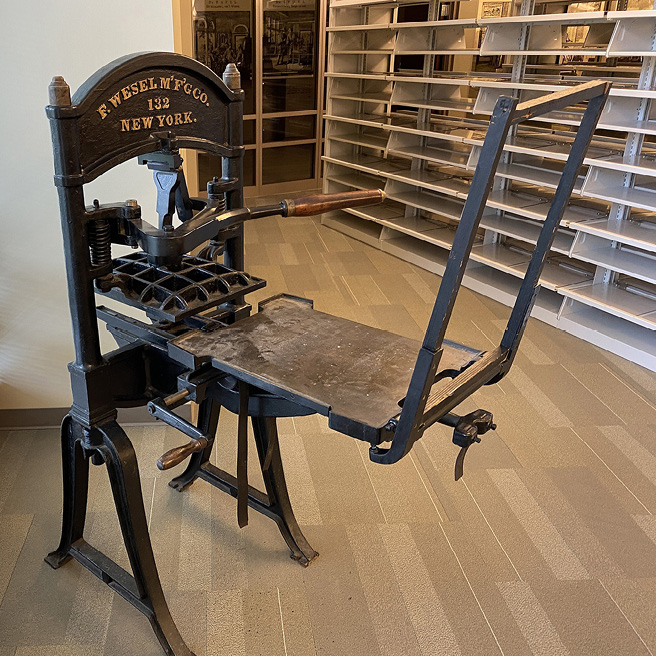
When the press arrived at our library, it was inoperable. It was basically a giant 500-pound paper weight. Being somewhat mechanically minded and knowing my way around a woodshop, I took on the responsibility of bringing the press into working order. The first thing I replaced were the girts, or leather straps, used to move the carriage in or out. The original girts were dried, cracked and broken. Traditionally girts were made from the back of a horse hide or bull hide (Moxon 1683, 72), but I purchased some vegetable-tanned leather straps which worked well for this purpose. Once the girts were replaced, the carriage moved in and out under the platen. Second, I created a new tympan, which is a wooden and metal frame wrapped with material designed to hold the paper and to soften or equalize the pressure supplied by the platen. I also created a forestay to support the heavy cast-iron carriage when it was in the outer position.
At this point, I had been in contact with the leading expert on iron hand presses, Robert Oldham (Oldham 2006). He was passionate about seeing our antique press being used again and offered to travel to Atlanta to help us get the press up and running. In August of 2021, Oldham shared his wisdom, and the two of us finished setting up the press, which involved creating a new frisket that we welded together at my shop. I mention the help of Oldham since it is often beneficial not only to rely on the expertise of others, but also their connections. Oldham secured for us various tools and equipment necessary for running a letterpress (things such as reglets and furniture, leading and spacing, quoins, a pica pole and a composing stick). He also put us in touch with a local printer who gave us a large chase. The library purchased its own metal type from Skyline Type Foundry in Prescott, Arizona. Oldham also taught me that it is important not to become overly preoccupied with historical accuracy. For instance, we used elastic bands instead of paper in the frisket and rare earth magnets instead of quoins to secure the printing block. Demonstrating the principles of printing is more important than historical accuracy in every detail.
A different possible title for this presentation is, “How learning about letterpress printing has made me a better librarian.” I had tried to learn as much about letterpress printing as I could. This included reading books, browsing websites, and taking classes related to early printing. I printed at a local letterpress shop and purchased a couple of smaller presses for myself. As a student of early printed books, this dive into the world of letterpress printing helped me better understand how printed books were created and I began to look at early printed books with new eyes.
Letterpress printing has the connotation of printing with moveable, metal type, but there are traditional approaches used in letterpress printing that either supplement or replace the use of metal type altogether. These include wood type, printing plates, such as stereotypes or copper plates, and printing blocks or cuts. All of these are materials that people can still acquire today at antique stores, auction sites, or from people in the letterpress trade.
One can easily find used metal type at online auction sites and there are still a couple of foundries in North America making type. The advantage of using metal type is that the chemical composition and general features of type today have not changed much since Gutenberg in the middle of the fifteenth century. For that reason, demonstrating printing using metal type is perhaps the most authentic way to show the invention of printing. Yet this form of printing is extraordinarily time consuming. For unskilled individuals (like myself) it takes hours to compose a single page of dense type. This is a skill that only becomes efficient after doing it for a while. It also requires having a lot of type on hand and a way to store and organize that type when it is not in use. For that reason, I like to keep type around to show what it entails to compose with metal type, but I generally do not print with metal type for classes or other visiting groups. This led me to explore alternative technologies to use with the printing press.
The sibling of metal type is wood type, which was popularized in the nineteenth century. Wood type is typically made from a hardwood such as beech or maple and is useful for printing large letters whereas metal type is suited for smaller letters and finer details. Wood type is often associated with posters and metal type with books. Wood type as artifacts are popular antiques and purchasing a full set of wood type for printing starts out at several hundred dollars. Printing with wood type is a great way to get people into the practice of using moveable type, which has similar organization and storage requirements to metal type.
![A close-up photograph of moveable type locked up in a printing forme and placed on the bed of a printing press. In addition to the type, there are furniture pieces (wooden spacers), quoins, and a partial view of an ink roller.]](https://serials.atla.com/proceedings/article/download/3571/version/3803/4922/19582/ToolsAndTechnologies_Image2.jpg)
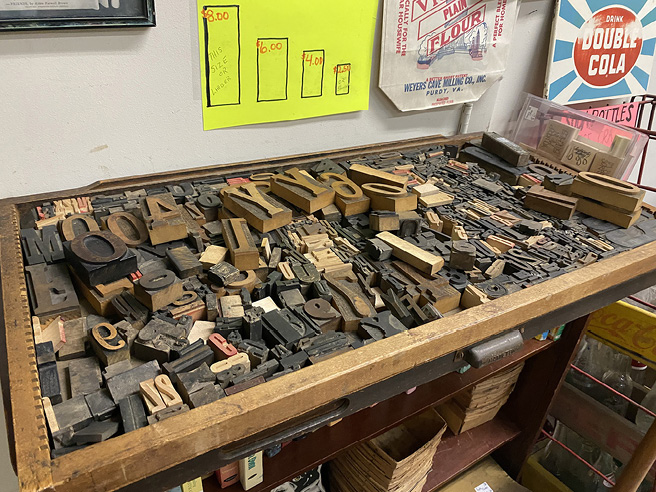
One low-hanging fruit is acquiring pre-made printing plates and cuts. Through eBay, we purchased a printing plate for The Hymn and Tune Book for Use in Old School or Primitive Baptist Churches (1886). Having this plate is a convenient way to discuss printing because we can put the printed book on display open to the page of the printing plate to show students how the two are related. Photo-etched zinc printing blocks, or “cuts” as they are often called, are also a great option to present a design, illustration, decoration, or advertisement that is ready to be printed. Ebay is chock-full of printing cuts and they are relatively inexpensive. The main drawback with printing cuts is that finding one that is useful for a particular purpose is a challenge because what one can find online is usually a bit random. Still, people find the experience of printing from cuts quite entertaining.
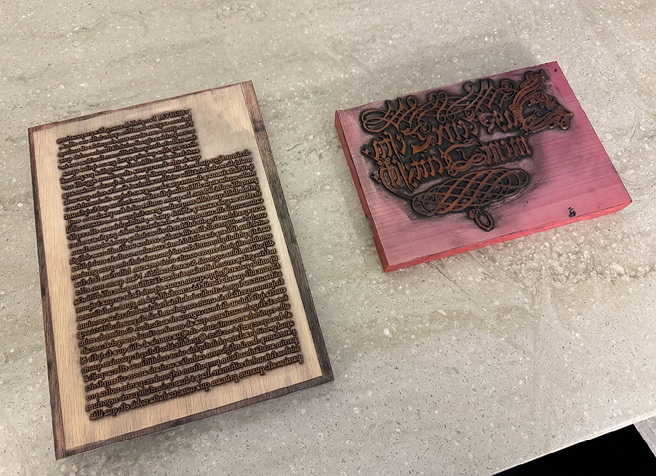
Advances in technology allow us to develop new types of raised surfaces that can replicate the process of traditional printing with type and blocks. One of the attractive features of these newer approaches is the ability to begin the design work using image editing tools or 3D modeling software. The idea is that we can create something using modern skillsets which compensate for our lack of traditional skillsets such as cutting a woodcut. There are three technologies that I will address for helping to demonstrate printing: photopolymer plates, 3D printing, and CNC machining.
Today, many letterpress printers use photopolymer plates for printing, instead of (or to supplement) printing with metal type. These are light-activated resin plates that can be adhered to a thicker base. Companies like Boxcar Press in New York can create these plates from digital files. They also print very well. We had a couple of plates made for us at the library. The first was a reproduction of the first page of Nicolaus Jenson’s edition of Eusebius’s De evangelica praeparatione (On the Preparation of the Gospel). This is not only Jenson’s first printed book, but also the first book that employed Jenson’s celebrated Roman type. I chose this for the print not only because of Jenson’s typography, but because this allowed us to draw attention to an interesting feature of book decoration. Many fifteenth century books have decorated initial letters, which come out of the manuscript tradition. Our copy of De evangelica praeparatione was professionally illuminated, but the crafts person responsible for supplying the initial letter used a P instead of an E. This raises questions about the process of illumination—unlike some other early printed books, Jenson did not use guide letters and it is possible that our illuminator was not literate or was absent-minded when they supplied the wrong initial. This unusual mistake provides us with the opportunity not only to highlight the mistake, but to correct it using printing sheets that we printed on our press. By printing the page without the initial letter, students or visitors could add their own decorated initial in their own style. The second photopolymer plate we had made was that of the woodcut title page of the September Testament, the first printing of Martin Luther’s German New Testament. At an event commemorating the five-hundredth anniversary of the September Testament, we set up a proof press so people could create their own printing of this historic title page.
We wanted to implement the use of emerging technologies that were not often associated with letterpress printing and so we first worked with the makerspace on campus to recreate a woodcut from our collection using a 3D printer. This was not our library’s first foray into 3D printing. In 2017, we 3D printed a model of an indulgence chest for use in an exhibition, which gave us optimism about this new use of 3D printing. However, the result of our initial test was less than sophisticated. Our 3D printed woodcut was not perfectly flat and because of the way that the 3D model was designed, many of the finer sections were not properly supported and broke off. Our model could have been constructed differently or scaled larger to bring out better detail and so we plan to revisit this, possibly with a resin printer. Others have used 3D printing in place of wood type and the examples I have seen seem to be very promising (for example: https://www.printmypart.co.uk/single-post/2017/11/16/3d-printing-letterpress-printing-blocks)
We have experienced more success with another technology for creating woodcuts: a computer numerical control (CNC) machine. Though there are similarities between the two technologies, 3D printers and CNC machines, there is a fundamental distinction. 3D printers (filament and resin printers) work by building up objects layer by layer. It starts with nothing, and by the end of the print job there is a 3-dimensional object. CNC machines, or more specifically CNC router machines, work by removing material. A CNC machine starts with blank material, usually a piece of wood, a sheet of plywood, or plastic, and carves into that material. Both technologies are computer operated and run on particular types of code.
To make a woodcut, I started with a relatively simple image. Despite using modern technology, I knew I was not going to be able to reproduce the fine detail of an Albrecht Dürer woodcut. The first image I created was a printer’s mark for Andreas Torresanus, a fifteenth-century printer from Venice. To produce this woodcut, I scanned the original image from the printed book, cleaned up the image in Adobe Illustrator, and prepared the file in a program called Carveco Maker. In this program one can designate what type of cuts to make, what endmills to use, and how deep those cuts should be. Carveco Maker generates the G-code, which governs the speed and paths of the router along X, Y, and Z axes. The image of the printer’s mark was carved on to a piece of cherry wood and when printed with red ink made a fairly accurate representation of the original mark.

The second woodcut I created was from the 1477 German Bible printed by Anton Sorg. The woodcut is a relatively simple depiction of St. Paul sitting with a codex and holding a sword. Given the level of detail that I could easily attain using the CNC machine, I decided to enlarge the original by about 300 percent. The woodcut was carved into MDF (medium density fiberboard), rather than a hardwood, mainly because MDF stays flat, and I had good experiences carving into MDF with minimal tear-out. Though MDF absorbs ink more than hardwoods, it did make for a great printing medium. We have used this same wood block to print a few hundred woodcuts. And while the CNC is a remarkable tool that can (mostly) replicate the traditional woodcut, it does lack a little bit of soul. But it makes up for it with dust and noise.
I continued to play around with the CNC machine and produced other forms of artwork. I first experimented with making wood-type posters, but progressed to images, such as one of Martin Luther or a multi-colored woodblock adaptation of Vincent van Gogh’s “Skull of a Skeleton with Burning Cigarette.” Thus, one can take the medium of printing with CNC woodblocks much further than trying to replicate historical printed images.
Part of the problem using tools like 3D printing, resin printing, or CNC machines, is the learning curve with respect to the specialized software and the idiosyncrasies of the machines themselves. Of course, there are often online communities that are good sources of information and help for these technologies, but, in general, modeling prints and designing CNC woodcuts requires a lot of time. The payoff is the ability to create something that is unique and can have direct relevance to your library’s collections. Another consideration is cost, not only for the printers or machines and the consumables, but also potential software subscriptions that may add up.
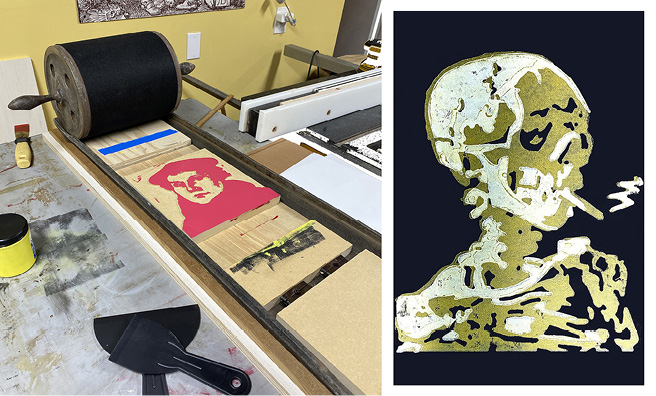
I have simply offered a few ideas of how modern technology can help aid in demonstrating the printing process, although there are simple and inexpensive approaches to printing for people who do not want to invest in one of the aforementioned technologies. For instance, a few years back my kids and I used Lego bricks to print Valentine’s Day cards. Anything with a raised surface can be used to print, so the hurdles of technology or costs should not be prohibitive.
Library Instruction and the History of the Book
The various media we have used to demonstrate printing has been incorporated into our library’s instruction to classes and visiting groups. Being part of a university, we have both undergraduate and graduate students visit the library, and we work with K–12 students through our Hands on History program. So when we approach the topic of book history, we try to tailor our approach to the audience, but the essence of the content and the materials used are generally unchanged.
While it is important to point out that the advent of printing in Europe is certainly not the beginning point of book history (nor even of printing, which developed earlier in East Asia), this does seem to be a useful starting point since this is the period in Europe’s history that underwent the largest changes both in terms of bookmaking but also culturally with respect to the Renaissance. By focusing on the fifteenth century, one can contrast the two contemporary modes of book production: manuscripts and printed books. It is helpful to ask questions such as: What would be involved in manuscript work versus what was needed to print a book? How long would it take to copy a book, such as the Bible, by hand? How long would it take to print the same book with type? When might one method be more advantageous over the other? Physical objects such as manuscripts, printed books, metal type, and composing sticks help complicate the situation since there is much more work involved in printing than pressing a button.
After talking about printing comes the fun part of using the printing press to pull prints. The process includes loading paper in the tympan, inking the printing forme using a brayer, positioning the bed under the platen, and of course pulling the handle to lower the platen and make the print. We demonstrate how the work is done, but let students do the work themselves. Sometimes inconsistencies in the print, due to inking or uneven pressure, show how the variables affect the outcome. We have printed a few different media on the press, but people seem to enjoy printing the woodcut of St. Paul the most.
This presentation has put a lot of emphasis on printing, but this is, of course, only one aspect of the history of the book. One could trace the history of the book through various types of media, such as cuneiform tablets, papyrus manuscripts, scrolls, codices, palm leaf manuscripts, and woodblock prints. We also address the materials used in traditional Western books, which may include vellum or linen paper, leather, wood, animal-based glue, linen thread, ink, and writing instruments. There is an undergraduate class called “Writing with Animals,” for which we have done presentations showing how deeply instrumental animals were for the production of books. For the class, we discuss vellum as both a writing substrate and cover material, various types of leather bindings, tortoise shell bindings, glue for bookbinding, quills, worm holes, and the various depictions of animals in books and manuscripts.
Another tool we have used on various occasions is a reproduction of Martin Luther’s 1529 German Litany. I selected this short book for its length and format. Since it is only sixteen pages in octavo format, it was originally printed on a single sheet of paper. Ann McShane, our digital assets librarian, scanned the original work. Then, using Adobe Photoshop, I arranged the pages onto a double-sided sheet which we had printed. Thus, this single sheet of paper shows how an entire pamphlet could be printed with two pulls of the printing press. After the sheet is folded, sewn together, and cut, one is left with a printed book in the style of the sixteenth century. We’ve combined this octavo with a paste-paper binding workshop offered through our Conservation department, so that one could have a unique, but also historically-fitting, binding for their book.

Exhibitions
Exhibitions offer another venue for presenting information related to the history of the book, since this allows us to combine text, artwork, books, artifacts, props, multimedia, and activity guides to tell the exhibition’s narrative to various age groups. It goes without saying that an exhibition related to book history should include books. Books tell their own histories through their colophons, their accounts of printing, depictions of printing presses, or images of those involved in the craft of printing. Yet books, through material evidence, also provide details of the people with whom they are associated. Books can provide a lot of points of discussion, including their content and their sources of information, the context in which they were printed, how and when they were decorated or bound, who owned them, and how they were used. Books as physical objects connect the world of today with those people who made them hundreds of years ago. For instance, seeing a simple fingerprint, in the same black ink as the printed text, establishes a connection between us and the Jewish printer Eliezer Toledano of Lisbon (or his assistant), who printed Hebrew texts under the looming threat of persecution and expulsion in the Iberian Peninsula. Handwritten notes correct the printed text of Lucretius’s De rerum natura. Personalized bindings owned by the Earl of Sunderland highlight the craftsmanship of early eighteenth century bookbinders. A bookplate designed by Pablo Picasso for his friend and art dealer’s son, Alexandre Paul Rosenberg, illuminates some of the interconnectedness of the twentieth-century art world and book collecting. Knowing the history of a particular book adds an extra element of appreciation, elevating it from a simple witness of its original time period.
Books or other contemporary prints become the source of exhibition artwork and when enlarged present their features in unintended, but sometimes powerful ways. One of the best illustrations of an early print shop is that of Johannes Stradanus called the Impressio Librorum, published in the late sixteenth century. The illustration demonstrates various tasks of the print shop, including composition, correcting prints, inking presses, operating the press, and drying and collating printed sheets. Though our library does not own a copy of the Stradanus print, high quality reproductions of it are in the public domain and freely available for use in exhibitions.
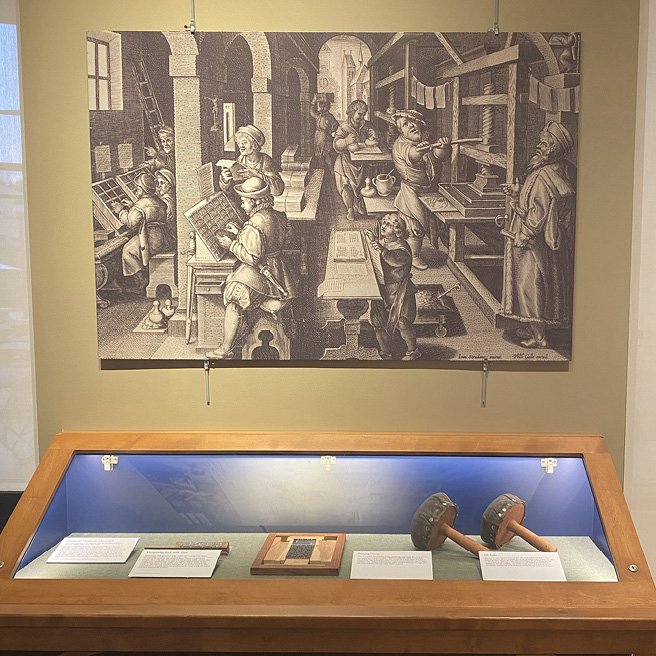
Artifacts, props, and reproductions are excellent tools for presenting glimpses into various aspects of book history. The curators of our Materiality of Devotion exhibition (2018–2019) included a section on the implements and elements of writing, which included examples of a reed pen, a feather quill, yellow ocher, malachite, lapis lazuli, and oak galls. For last year’s This Sacred Art exhibition, I included various props from the printing process, including a few lines of type on a composing stick, ink balls, and a prepared printing forme with the text of John 1 in Latin. In another section we included two hand-carved woodcut blocks by the artist Jorge Lar of Denmark, which were used to print his edition of Aesop’s Fables. Having these props on display allows visitors to visualize what tools and materials were needed for book production.
Props can often be enhanced by supplying additional context. For this reason, we employed the services of two artists who created short videos demonstrating their respective areas of bookmaking. The two videos were simply looped to show repeatedly in the gallery for people to view at their leisure. The first artist was Jorge Lar of Prelo Press, who provided us the woodcut blocks and his edition of Aesop’s Fables. Lar participates in various demonstrations at fairs and other events bringing the traditional craft of printing to public audiences. In the video he recorded for us, he presents traditional printing practices: he levels and sets the printing forme, dampens the paper, inks the forme with ink balls, and pulls multiple prints using his replica printing press. While giving tours of the exhibition, people would ask questions about some of the props we had on display, and I was able to point them to the video to show how they were used. The second artist we worked with was Julia Bangert, an illuminator at the Gutenberg Museum in Mainz, Germany. We asked Bangert to create an illuminated E for our Eusebius print and she did amazing work and provided a wonderful video for us. Though Bangert used modern paint brushes, the technique imitated historical decoration found in incunabula. The video she supplied was quite popular as people were drawn to seeing the talented artist at work.
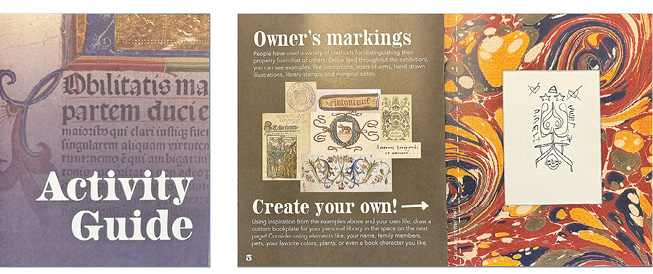
Lastly, we have used printed brochures, catalogs, and activity guides to convey information from the exhibitions for various audiences. The activity guides, developed under the direction of our Coordinator of Digital Initiatives, Liz Miller, are aimed at K–12 students, rather than college students. These guides relate important information about the exhibits in fun and interesting ways, such as fill-in-the-blank questions, scavenger hunts, crosswords, and drawing exercised. We had a section on book-ownership in the exhibition and here in the Activity Guide you can see that students were asked to create their own version of a bookplate, an example of which you can see in the image on the right.
I hope this presentation engenders a larger conversation about methods of incorporating the history of the book into library instruction. Though this is what has worked at Pitts Theology Library, it may look very different in other theological libraries. Some libraries have book labs and makerspaces and are well equipped to include hands-on learning as part of their curriculum. Yet the entry point for doing this type of teaching is not formidable. A small hobby letterpress can often be found for a few hundred dollars and, as I mentioned, printing cuts are abundant. Though not every library has a 3D printer or CNC machine (ours certainly does not) it is possible that people in the wider community would be happy to lend their services for educational purposes. Or there is always the Lego brick route. In terms of metal type, I find it useful to keep some around, perhaps in a composing stick or printing forme, for making the connection with Gutenberg and the most common way books were made in the West for the 500 years following the 1450s.
Earlier I mentioned that as librarians we have a special interest—some may say calling—to study the history of the book. I personally have found the subject matter quite rewarding since it addresses topics like human ingenuity, technology, and culture. Interacting with a 500-year-old book gives me a deeper appreciation for the content of that book and how many people were involved in bringing that book into the world. It is a remarkably rewarding experience to be able to share this information with students and others and so I hope that this presentation can help others in religious and theological libraries to think more about their work with teaching the history of the book.
References
Bacon, Francis. 1813. The Novum Organum Scientiarum: In Two Parts. Translated by Peter Shaw. London: M. Jones.
Blades, William. 1819. The Pentateuch of Printing, With a Chapter on Judges. Chicago: A. C. McClurg and Company.
Eisenstein, Elizabeth L. 1979. The Printing Press as Agent of Change: Communications and Cultural Transformations. 2 Volumes. Cambridge: Cambridge University Press.
Gamble, Harry Y. 1995. Books and Readers in the Early Church: A History of Early Christian Texts. New Haven: Yale University Press.
Marston, Thomas E. 1956. “The Catholicon of 1460.” The Yale University Library Gazette 30: 89–93.
Moxon, Joseph. 1683. Mechanick Exercises: Or, The Doctrine of Handy-works: Applied to the Art of Printing, The Second Volumne. London: Printed for Joseph Moxon on the West-side of Fleet-ditch, at the Sign of Atlas.
Needham, Paul. 1990. “Haec Sancta Ars: Gutenberg’s Invention as a Divine Gift.” Gazette of the Grolier Club 42: 101–120.
Oldham, Robert W. 2006. A Field Guide to North American Hand Presses and Their Manufacturers. Doswell, VA: Ad Lib Press.